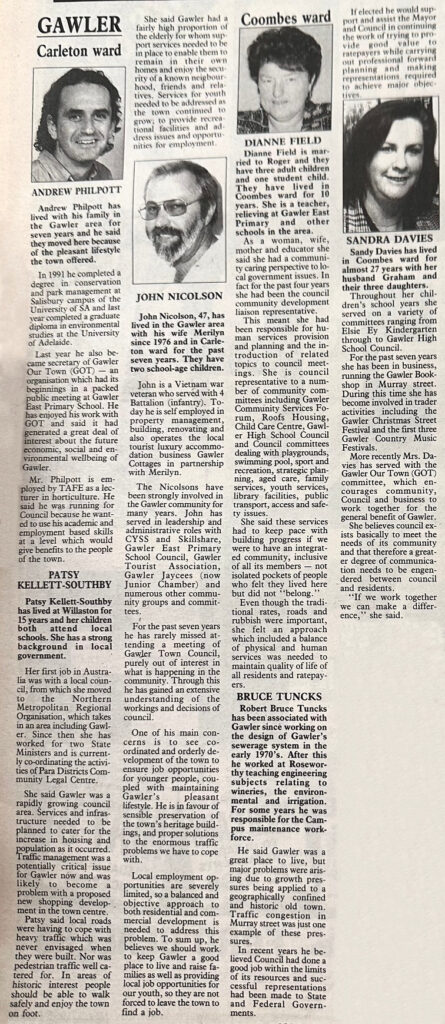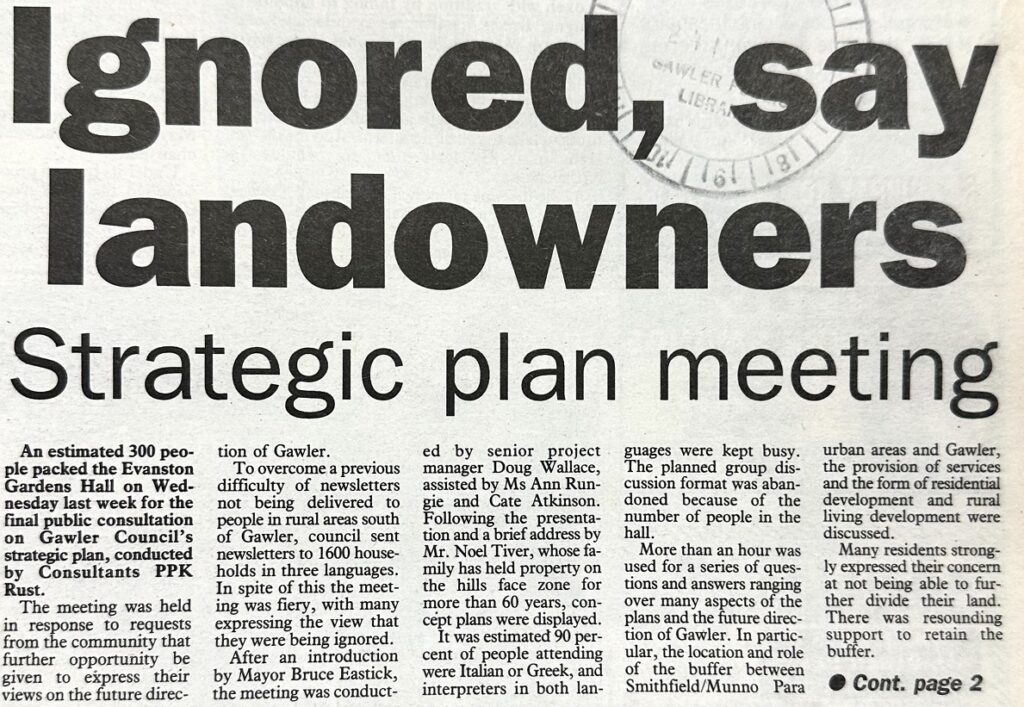Let’s take a trip back to the year 1995. The winner of the Triple J Hottest 100 was Wonderwall by Oasis, the Prime Minister was Paul Keating, and it was a Town of Gawler election year.
There are a couple of changes to note here compared to 1997. Firstly, we’ve reached the point where Council terms only last two years. Also, we’ve finally moved back in time to before the start of postal voting at Council elections – it’s all in-person booth voting from here on out.
As Gawler Council election years go, this was a quiet one, with competitive elections in only two wards. In fact, it was quiet enough that I’d like to start with something that shook up every Council in South Australia that year instead.
The South Australian Council Purge

The Bunyip, June 21st, 1995. (I also enjoyed the bonus article about the newspaper’s feud with a morning radio host.)
Council boundary discussion was in the air across the state. It had only been ten years since Gawler’s last change of boundaries in 1985, but the Town of Gawler was already on the march again to secure its future for the long-term. A ministerial committee on local government reform had been set up by the State Government, and Gawler wanted its boundary preferences on record.
This suggested boundary (I’ve made the earlier image clickable so you can zoom in) is far more ambitious than Gawler’s current-day proposal (notably, it includes Roseworthy). According to the article, this proposed boundary was the same one formulated by a 1973 Royal Commission into local government, which I’ll be excited to read when I get that far back.
Inevitably, Gawler’s proposal prompted a response in the following week’s Bunyip from neighbouring Light Council to the north, who were none too happy with the idea, claiming (legitimately enough) that it would jeopardize Light’s viability as a Council.
They had similarly complained ten years prior, when they had lost parts of Gawler West and Willaston to Gawler’s new boundaries. This time, however, not even Roseworthy was safe.

The Bunyip, June 28th, 1995.
The ensuing boundaries debate rocketed back and forth. Gawler Councillor Peter Graham responded to this piece by invoking the phrase “communities of interest” several times to explain why the changes made sense. He also agreed that yes, the Light Council would not be viable under this proposal, but that fact merely reflected that Light’s boundaries were inefficient and arbitrarily drawn up in the first place.
One point brought up by Light Council chairman (which was what they had instead of a Mayor) Des Shanahan was that Gawler was pre-empting the upcoming state government report on local government reform. Ironically though, when that ministerial report was released, it would have no room for the existence of a Light Council at all.
The government preferred a huge Gawler, well beyond even what the Gawler Council wanted. Gawler’s plan was to solidify its own nearby sphere of influence while retaining Gawler as its centre, not take in other self-sufficient towns and become a decentralized regional Council.
Freeling? Greenock? Two Wells? Port Gawler? All part of the new proposed Gawler map (which, again, I’ve made clickable/tappable since I know most people read this on their phones). I’ll say this for the proposal – it at least brings together locations with Gawler in the name, though to complete the collection, the City of Adelaide might need to hand over Gawler Place.
The Bunyip, August 2nd, 1995.
The state government weren’t here to discretely match people to their local communities of interest, they were dreaming big; they simply wanted to get rid of two-thirds of South Australian Councils. In the end, Gawler didn’t get its boundary reform proposal, but on the plus side, it was one of the few Councils in the area that survived the purge intact.
To the north, Light Council would soon amalgamate with Kapunda Council to form the modern-day Light Regional Council, and the Angaston, Barossa and Tanunda councils would combine into the modern Barossa Council. To Gawler’s south, the City of Munno Para would merge with the City of Elizabeth to form the City of Playford.
Some degree of amalgamation was probably a good idea, but in their fervour, the state government also rampaged across South Australia creating some patchwork monstrosities out of completely separate communities. The aim seemed to be to increase efficiency, but many Councils would end up no more efficient than they were previously. As it turns out, efficiency isn’t as simple as just amalgamating into mega-Councils.
Now, onto the elections.
The Mayoral Election
There were no challenges to Bruce Eastick again this year. This isn’t a major surprise; you would need both a big community profile and a lot of prior planning even to consider challenging someone as well-known around town as Dr Bruce Eastick, a several-term Mayor who had also spent 23 years as the local Member of Parliament.
Also, challenges to incumbent mayors will, generally speaking, become a lot rarer as we move back in time.

The Bunyip, April 5th, 1995.
The most interesting thing to note here is probably that the election is being conducted by Council staff; these days it has to be done by independent officers from the Electoral Commission. We’ll be seeing Robin John continue to show up for a while yet – he was the Town Manager/Town Clerk (a.k.a. CEO) of Gawler for 17 years from 1981-1998.
The Councillor Elections
Just like last time, this election had six wards with two Councillors each, for a total of twelve Councillors.
Unfortunately, of the fourteen candidates who ran, I only have the Bunyip’s candidate profiles for six of them, because the other eight got an easy ride this year, winning automatically in their wards.

The Bunyip, May 3rd, 1995.
Notably, John Nicolson’s wife Merilyn (who was mentioned a couple of times in his candidate profile) would successfully run to be a Councillor herself nineteen years later, at the 2014 elections.
Also, I couldn’t find any numbers on how many votes the candidates received this time around, but if I do, I’ll edit them into the post.
Carleton Ward
The two wards that did have elections both had low turnout; the Bunyip reports that only 12% of eligible voters showed up. These are the lowest numbers I’ve seen so far at a regular election, but I’m not too surprised since this probably felt like a by-election to the few Gawler residents who could even vote this time around.
A rising tide lifts all boats, and likewise, a Mayoral election lifts all votes (especially when the elections are in-person rather than postal).
In Carleton Ward, there were three candidates for two positions:

Winner: John Nicolson
- New. Would quit in late 1996 and trigger a by-election.

Winner: Andrew Philpott
- New.

Missed out: Patsy Kellett-Southby
- New. She would win two years later in the 1997 elections, though without the “Southby” in her name by that point.
As you can see, neither of the incumbent Councillors for this ward ran for election this time, leaving a fresh field of challengers.
In my experience, there’s usually a strong correlation between not providing an official photo and not getting elected. I suspect that it’s because: a) people like to see who they’re voting for, and b) it’s also just a sign of broader problems, like the campaign being low-effort or thrown together at the last moment.
There was also a by-election in early 1997 to replace John Nicolson. Only one person applied for the one open position.

Scott Fraser’s by-election saw him elected for the remaining five months of the Council term. He didn’t run again in 1997, but would eventually return as a Councillor in 2010.
Coombes Ward
Coombes Ward was the other ward to have an election; there were three candidates for two positions.

Winner: Dianne Field
- Incumbent.

Winner: Sandra “Sandy” Davies (no relation)

Missed out: Robert Bruce Tuncks
- New. Another candidate who didn’t have a photo ready for his nomination.
- He was a lecturer at Roseworthy College and was involved in the establishment of Trinity College. Went by his middle name Bruce rather than his first name.
Trevor White, the other Coombes Ward incumbent, switched to Reid Ward for this election, which would turn out to be a smart decision, considering that he won that election by default.
The Automatic Winners
I’ve already introduced the wards more thoroughly in my last post, so I’m going to speed through the automatic winners here. This is probably the most predictable section I’ve ever had so far; all eight of the candidates were incumbents, with no challengers running.
Winners (Willaston Ward): Phyllis “Penny” Hopper, Neville Elphick
Winners (Turner Ward): Lillian Bartlett, Roland Chatterton
Winners (Martin Ward): Warren Dibben, Peter Graham
Winners (Reid Ward): Tony Piccolo, Trevor White
Trevor White would quit before the end of 1995 and trigger a by-election.
Speaking of which, welcome to:
Gawler’s tiniest by-election

The Bunyip, October 5th, 1995.
This is a tragically low turnout, even for a by-election: a turnout of 4.5%, and a result of 55 votes to 20. If I’m doing my maths correctly, this should be a ward that has around 1700 voters. A showcase of the potential benefits of switching to postal voting?
Danny Bombardieri, who won, was a former Councillor who had last been on Council in 1989.
Meanwhile, in Kudla
It’s time for one of our most consistently recurring topics: the Southern Rural Areas saga. I suspect that the only thing that will stop this segment from recurring forever is that prior to 1985 these suburbs were part of a different Council.

The Bunyip, May 24th, 1995.
All the usual aspects are here, just as they were in 2000 and in 2006; the local landowners feel ignored by the Council and have a “fiery” meeting with council staff and Mayor Bruce Eastick, who have brought in consultants for a strategic plan. Many residents also “strongly expressed their concerns at not being able to further divide their land”.
One new aspect, though, is the language barrier. This additional meeting incurred a few extra expenses for Council, as brochures also needed to be translated into Italian and Greek. Apparently, these groups made up 90% of those in attendance, and “interpreters in both languages were kept busy”.
These days, the meetings and the strong concerns about sub-divisions do still happen, but entirely in English. Either Kudla’s demographics have changed, or everyone’s gotten more confident in their English-speaking skills after 30 years of presentations to Council.
Toilet Troubles

This one is both a classic Council issue (the state of the toilets in Julian Terrace) and a classic Bunyip pose. As someone who has experience with local news journalists, I can almost guarantee that they told him to try various disappointed poses while they lined up a good photograph.
Usually, the fallback position for negative local news stories like this is the ever-reliable “arms crossed to show that we’re not happy” technique (a.k.a the NIMBY pose), but I do admire Cr Warren Dibben’s variation here that gives off a “this issue is giving me a headache” vibe instead.
Next time, we will be looking at the 1993 elections, during which Tony Piccolo has been acting Mayor for several months due to the death of Mayor Bob Bartlett while in office. See you then!

Pingback: 1993 in Gawler's Election History - Cody Davies - Town of Gawler Elected Member
Pingback: 1987 in Gawler's Election History - Cody Davies - Town of Gawler Elected Member
Pingback: 1985: The Year Gawler's Boundaries Changed - Cody Davies - Town of Gawler Elected Member